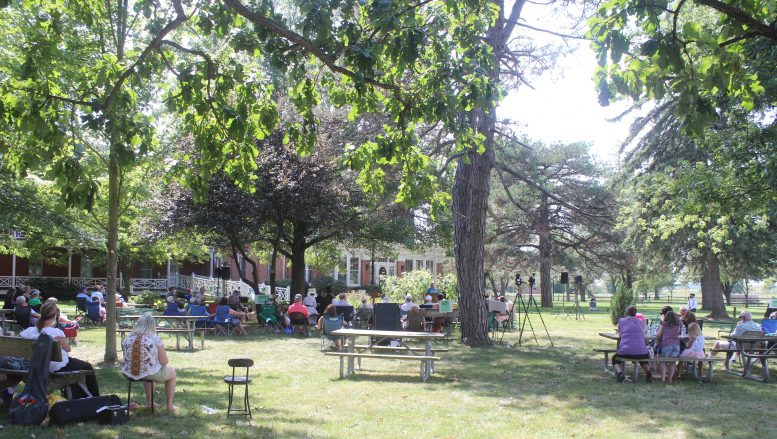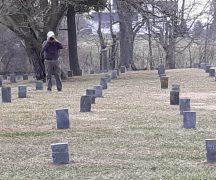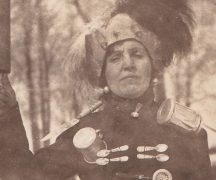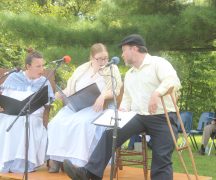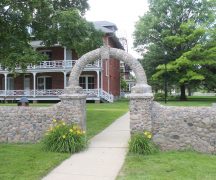By DAVID DUPONT
BG Independent News
It’s not hard to imagine that in a generation or two, a Living History presentation will address our current times.
We are living in historic times, experiencing a pandemic, civil unrest, and a highly contentious presidential election.
More than 100 people on Sunday took a break from all that to gather on the shaded lawn of the Wood County Museum, masked up and socially distanced, to hear voices from earlier times.
The 17th Living History Presentation focused on the roots of Wood County, which along with 14 other counties, is celebrating its Bicentennial.
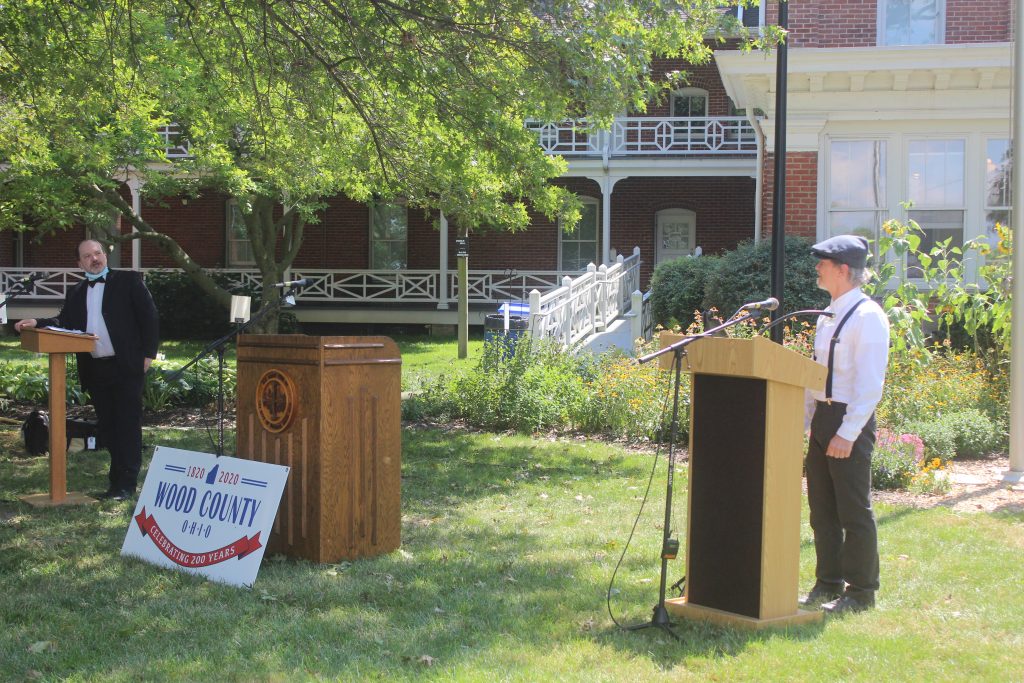
These milestones, whether of birth, marriages, graduations, or deaths, are not important in and of themselves, , said Holly Kirkendall, the museum’s curator, but rather because of “the corresponding emotional connection” people have to them.
She said: “I believe there comes a point in any person’s life when people become aware of their mortality. It can be a little unnerving so it’s natural to become nostalgic, looking back to happier and simpler times.”

History is made up of those memories. They are contained in documents, old news reports, oral histories, and objects. But this vision is not unchanging. Perspective shifts over time, she said. The context of a person’s life – age, ethnicity, social status – also colors our view of the past.
Sunday’s program was framed – quite literally – by two newspaper editors and authors.
Bob Midden stepped forward first as Charles Sumner Van Tassel, author of “The First Hundred Years of Bowling Green” and editor of the Wood County Sentinel. He announced that the county was celebrating its bicentennial. “That’s something worth crowing about.”
With a blustering tone, he spelled out his background and how he undertook his historical research.
His ruminations were interrupted by the arrival of fellow newspaper editor and writer Charles Evers, portrayed by Thomas Edge.
After a bit of competitive jostling about their various accomplishments, including Evers pointing out he was the one who first hired Van Tassel to work at the newspaper, they decided to work together to tell the story of the county’s early years.
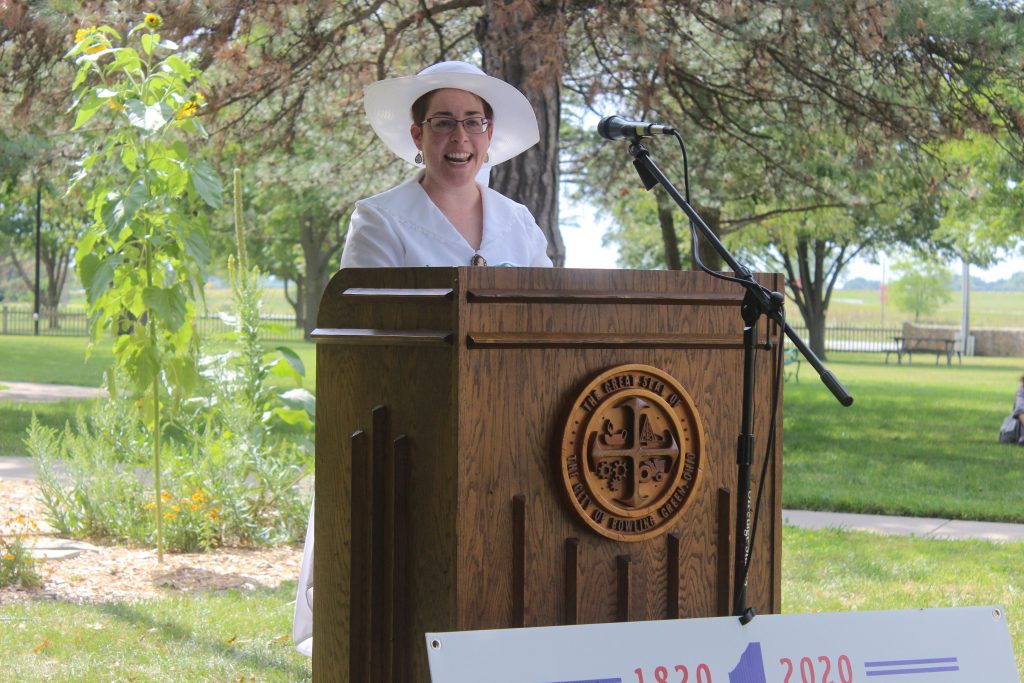
One by one they summoned witnesses from among the dead. Each honoree stood at a podium positioned between the editors, who reacted to the stories being told and occasionally asked questions.
The first voice was that of county Sheriff George Murray Brown, portrayed by the current incumbent Sheriff Mark Wasylyshyn.
Brown presided over the last hanging in county. Carl Bach was executed before a crowd of 10,000 in October 1883 for the murder of his wife, Mary. Her preserved fingers, which were cut off as her husband attacked her with a corn knife, have become a gruesome local artifact.
Reflecting Kirkendall’s comments of how perspectives change, the fingers in a jar will go back on display at the county museum in October in an exhibit addressing the issue of domestic violence.
Speaking through Wasylyshyn, Brown admitted to becoming more compassionate toward the murderer during his long incarceration at the county jail. “Hanging Carl Bach was the hardest thing I ever had to do,” he said.
Brown sent his wife and children out of town as a safety measure, and called for the National Guard.
After the execution, Brown took the timbers from the gallows to build a porch on his home on Conneaut Avenue. The home no longer exists.
Brown also supervised the hanging of another man, one who murdered an elderly woman. The hanging took place at the Ohio Penitentiary in 1896.
Also, part of Brown’s story was his service in the Civil War as part of the Ohio Volunteer Infantry. According to a tale told by his family, when his unit was captured by Confederate soldiers he was able to secure his release by showing a Mason medal that had been given to him by his father, himself a Mason. The rebel soldier was also a Mason, and so let him go. Brown later returned to combat, and after the war felt obliged to join the fraternal organization.
Another tale about a Civil War veteran that while amusing is not borne out by the historical record was one about Dr. John Whitehead, a prominent doctor.
A fellow soldier wrote that Whitehead kept trying to get a furlough and was refused until he received a wound in his upper leg. His commander still refused, but the doctor relented and Whitehead supposedly came home and married his wife.
The doctor, portrayed by Gus Coutinho, refuted this tale referring to his service until the end of the war, including being seriously wounded, and his marriage two years after the war’s end.
On a more serious note, Whitehead said: “As a doctor nothing is harder than not being able to help save a young man’s life. Facing his family, admitting his talent and education is not enough, is a terrible thing indeed.”
Whitehead knew that tragedy first hand. His son was shot in the head by a friend by accident while quail hunting.
Death of children was a tragedy experienced by several of the speakers.
Peter Kramp, a German immigrant farmer who was dubbed the “Oil Prince of Wood County,” lost his son Fred. The son was husking corn when he suffered a severe headache. Despite getting medical attention he died of what the doctor called “congestion.”
He was one of Kramp’s 12 children – 10 sons and two daughters.
When the Wood County Sentinel wrote of his son’s death it called the Kramps “a phenomenal family.” The large family had no “black sheep,” the paper reported. Kramp, who was portrayed by Geoff Howes, said that while he understood that “journalists like to exaggerate in order to sell papers, in this case they were right.”
The father did allow that one son had trouble with wives – he had six of them.
That prodigious family has left its mark on the county. Kramp, who died in 1913 at 78, tallied those who came after him: 22 grandsons, 18 granddaughters, 33 great-grandsons, 28 great-granddaughters, 71 great-great-grandsons, 59 great-great-granddaughters. And he added he couldn’t begin to count great- great-great-grandchildren. Some of those were in attendance, he said.
He left, he said, “many worthy descendants who are proud to call Wood County home.”
After this parade of men, Dr. Harriet Covert Battles, portrayed by Joyce Coutinho, rushed to podium. “What about the women?”
As first president of the county’s Women’s Suffrage Club, she bragged about the support local voters gave to the drive to secure the vote for women. She penned several “yells.” One began: “Here we come in the cause of right!”
Battles said she was “pleased as punch” to see the 19thAmendment pass in 1920.
Dottie Zimmerman, portrayed by Alyssa Garland, had a 50-year career as a teacher. Most of that time was spent in one-room school houses during a period when it was accepted that the day at a public school could start with a recitation of The Lord’s Prayer.
Zimmerman was the last person in the county to teach at a one-room schoolhouse. For 28 years she taught at the Portage Village School, and then at the Weston Township DeWeese school, the last one-room school in the county.
“The farmers in Weston Township loved their one-room school,” Zimmerman said. “They kept it open as long as possible. Their theory was if it was good enough for me, it’s good enough for my children and grandchildren. They would pay to keep the school open, and pay the full cost, even if there was only one student attending.”
She ended her career at the Weston School.
Zimmerman lived in Bowling Green in a large family home on North Main Street in Bowling Green. She shared the home at times with her nieces and rented rooms to other female students at Bowling Green Normal College.
Her life was touched by tragedy. One brother, James, was murdered during a robbery.
Evers recalled the crime. He reported on the trial, after being eliminated from the jury pool. The murderer was the only person to go to the electric chair for a crime committed in the county.
Another of her brothers, Frank, died after an operation leaving a wife and two young children.
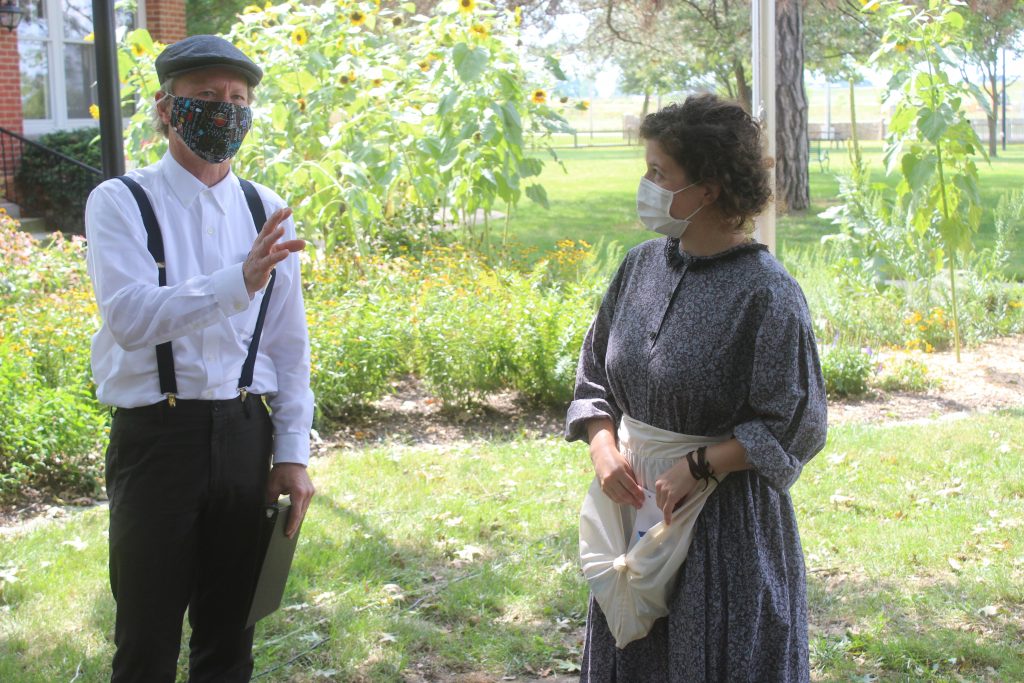
Death was an even greater presence in the life of Elizabeth LaFarrie, portrayed by Heather Bloom.
LaFarrie, born in 1800, was a pioneer wife whose family came to the Ohio frontier from Maryland. After a few years though they returned to Maryland where they had several children, all of whom died. The family eventually settled in Perrysburg in 1832.
It was a life of illness, where ague, a malaria like disease, was common. It was a life of hard work and isolation. LaFarrie recalled going months without seeing another woman.
Her husband, James, was credited with naming the Stony Ridge where he was post master.
Her husband died after traveling to help another family that had come down with cholera. He contracted the disease and died. She later lost two more children.
Many people admired her needlework, considering it artistic, and even until the end of her life she could recite poems she’d memorized as a girl.
“Everyone who has lived in Wood County has contributed in some way to what it is today in some important way,” Midden’s Van Tassel said.
“We’ve only scratched the surface,” Evers said. They had not talked about the ship builders of Perrysburg, the ditch diggers who drained the swamp, road builders, the glass factory workers, and the oil men, and women.
“All helped make Wood County what it is and played such a pivotal role in their own right,” Evers said. “The list goes on and on.”
Certainly, a hopeful sign that Living History Day will not soon run out of people to honor.

